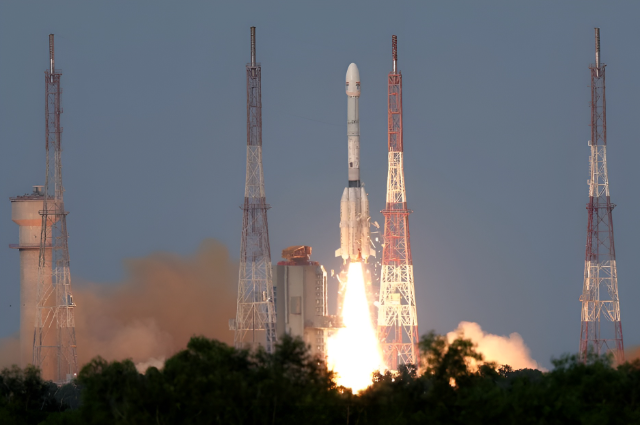The successful deployment of the NASA-ISRO Synthetic Aperture Radar (NISAR) satellite on July 30th represents a watershed moment of India-United States space collaboration. This groundbreaking earth observation mission stands as the culmination of years of bilateral scientific partnership, demonstrating how two nations can pool their technological expertise to address global challenges.
NISAR distinguishes itself as a pioneering venture in satellite technology, incorporating an innovative dual-frequency radar system that combines NASA's L-band radar capabilities with ISRO's S-band radar technology. This sophisticated approach enables the satellite to maintain continuous surveillance of Earth's surface with unprecedented precision and reliability, marking a significant advancement in space-based monitoring systems.
Revolutionary Earth Monitoring Capabilities
The satellite's cutting-edge radar system operates across multiple frequency bands, providing comprehensive data collection capabilities that surpass traditional earth observation methods. The integration of both L-band and S-band radars creates a synergistic effect, allowing for enhanced penetration through various atmospheric conditions and surface materials.
The mission's all-weather, round-the-clock imaging capabilities represent a quantum leap in earth observation technology. Unlike optical satellites that are hindered by cloud cover or darkness, NISAR's radar-based system can function continuously, providing consistent data streams regardless of environmental conditions.
NISAR's mission scope encompasses a broad spectrum of earth observation applications, including detailed monitoring of land surface deformation patterns, comprehensive analysis of ice-sheet dynamics, assessment of forest biomass variations, and real-time tracking of natural disasters such as earthquakes and flooding events. This multifaceted approach positions the satellite as an invaluable tool for understanding and responding to climate change impacts.
The satellite's high-resolution imaging capabilities enable scientists and researchers to detect subtle changes in the Earth's surface that might otherwise go unnoticed. This level of precision is crucial for early warning systems and long-term environmental trend analysis.
Technical Excellence and Innovation: Engineering Marvel
Dr. Narayanan's candid admission of pre-launch tension followed by relief underscores the magnitude of this technological achievement. As he reflected to NDTV, the moments leading up to liftoff carried the weight of years of development and international expectations.
The NISAR satellite holds the distinction of being the most expensive civilian earth imaging satellite ever constructed, a testament to the advanced technology and comprehensive capabilities it embodies. The satellite's impressive 12-meter deployable antenna system, designed with an umbrella-like configuration, represents a remarkable feat of space engineering that enables the mission's sophisticated radar operations.
Groundbreaking Orbital Achievement
This mission marked several significant firsts for India's space program. The launch represented the 102nd mission from the Sriharikota spaceport and the 18th deployment using the Geosynchronous Satellite Launch Vehicle (GSLV). However, what made this mission particularly noteworthy was its pioneering use of a sun-synchronous polar orbit, a departure from the traditional geosynchronous transfer orbit missions that had characterised previous launches.
The sun-synchronous polar orbit provides optimal conditions for consistent earth observation, ensuring that the satellite passes over any given point on Earth's surface at the same local solar time, thereby maintaining consistent lighting conditions for enhanced data quality and comparison.
Comprehensive Indian Space Capabilities: ISRO's Expanded Role
The Indian Space Research Organisation's involvement in the NISAR mission extended far beyond payload development, encompassing the complete spacecraft architecture. ISRO's responsibilities included the design and construction of the satellite's structural framework, power generation systems, inertial navigation systems, and propulsion mechanisms – essentially every critical component required for successful orbital operations.
This comprehensive involvement demonstrates ISRO's mature capabilities in satellite systems integration and its evolution from a recipient of international assistance to a full partner in complex space missions. The NISAR mission gained significant momentum during Prime Minister Narendra Modi's official visit to the United States, where the project received high-level political endorsement. This diplomatic backing transformed the mission from a purely technical collaboration into a symbol of strengthening the Indo-US strategic partnership.
Dr. Narayanan's recollection of the Prime Minister's announcement highlights the mission's importance as a demonstration of India's growing space capabilities on the international stage. The successful launch serves as tangible evidence of India's ability to compete and collaborate with the world's leading space powers.
Collaborative Success Story
The mission exemplifies the potential of international scientific cooperation, bringing together NASA's advanced radar technology with ISRO's reliable launch capabilities and spacecraft engineering expertise. This partnership model demonstrates how countries can leverage their respective strengths to achieve outcomes that might be challenging to accomplish independently.
Following the successful launch, NISAR has demonstrated excellent operational health with all critical systems functioning as designed. The satellite's solar panels have deployed successfully and are generating the required power levels for sustained operations. The current phase involves the careful unfurling of the satellite's sophisticated antenna system and comprehensive testing of all payload components.
The mission timeline anticipates a full operational declaration within approximately 2.5 to 3 months, following comprehensive system verification and calibration procedures. This careful approach ensures optimal performance throughout the satellite's operational lifetime. The precision achieved during the launch sequence has resulted in significant fuel savings for the satellite, extending its expected operational lifetime to 6-7 years. This extended duration maximises the return on investment and ensures sustained data collection for long-term environmental monitoring and climate research applications.
A Moment of National Pride
The successful launch and deployment of NISAR represents more than just a technological achievement – it symbolises India's emergence as a formidable force in global space exploration and earth observation capabilities. The mission demonstrates the power of international collaboration while showcasing India's indigenous technological skill.
As Dr. Narayanan aptly observed, this achievement serves as a source of pride for Indians worldwide, representing the culmination of decades of scientific advancement and international cooperation. The NISAR mission not only advances our understanding of Earth's changing environment but also establishes a new paradigm for future space collaborations between India and its international partners.
The mission's success paves the way for expanded cooperation in space exploration, earth observation, and scientific research, positioning India as an indispensable partner in humanity's quest to understand and protect our planet through advanced space technology.
. . .
References:

